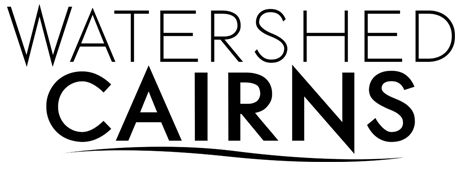Inspired by the effects of the 1993 Mississippi River flood in their hometown of St. Louis, Missouri, Watershed Cairns® artists Libby Reuter and Joshua Rowan create luminous photographs that draw attention to the rivers that form the Mississippi River Watershed. Most of the land between the Allegheny and Rocky Mountains, drains from fields and streets to sewers and streams into the Mississippi River and, ultimately, into the Gulf of Mexico, Although this watershed irrigates 90 percent of the nation’s agricultural exports and provides drinking water for 50 million people, most of us take its water for granted. Increased use, pollution, and climate change are putting this vital resource at great risk. Watershed Cairns’ fragile glass sculptures are photographed in wetlands, streams, rivers, and even storm sewers and junkyards to inspire viewers to see and protect their communities’ fresh water.
To make their work, the Watershed Cairns artists travel on country roads alongside the river with a van full of thrift store glass. Stopping at a compelling site, Reuter stacks the glass markers or cairns. (Cairns are the rocks that hikers stack to mark a trail, or as a memorial) Then, Rowan captures the light and color of glass and landscape in an evocative image, recording the latitude/longitude and information about the watershed. After Reuter disassembles and packs the cairn parts in the van, they continue on to find the next site for a new cairn.The resulting mages and cairns are exhibited with watershed information at museums and at www.watershedcairns.com.
Early images were created in Metropolitan St. Louis, Missouri. In 2016, Reuter and Rowan expanded the project to mark the entire Mississippi River Watershed. Beginning at the Mississippi River’s source in Lake Itasca, Minnesota. Over the next four years, they traced the river’s path from its origin to the confluence of the Mississippi and Ohio Rivers. In 2020, they made new work from the Ohio’s mouth at Cairo, Illinois, to its origin in Pittsburgh, Pennsylvania. They also published Watershed Cairns: The Mississippi River North, an 85-page, 9x12-inch paperbound book containing 45 images and text about the upper Mississippi River. They plan to be making new work on the lower Mississippi River in the summer of 2020
Exhibits of large-scale photographic images and the cairns at Midwestern museums have reached a diverse audience. 330,000 people visited the Missouri History Museum, St. Louis during the 2014-15 Watershed Cairns exhibit. Since then, individuals, families, and school groups have viewed the work at the following venues: Cedarhurst Center for the Arts, Mt. Vernon, Illinois, 2015; United States Army Corps of Engineers Great Rivers Museum, Alton, Illinois, 2016; Minnesota Marine Art Museum, Winona, 2017; The Audubon Center at Riverlands 2016 and 2018; St. Louis Lambert International Airport, 2019; and the Dubuque Museum of Art, 2020. Many exhibits included informational displays by local clean-water advocates, including soil and water conservation districts, state conservation and natural resource departments, Missouri Coalition for the Environment, and the Sierra Club. Grants from the St. Louis Metropolitan Sewer District, St. Louis Regional Arts Council, Missouri American Water, and the Mississippi River Network have supported the work.
Watershed Cairns artists value these partnerships with museums and environmental groups as a way of learning about pertinent issues and for the opportunities they provide to engage with the community. Libby Reuter serves on the water committee of the Open Space Council for the St. Louis Region and is a member of the East/West Council of Governments Water Resource Advisory Committee. The artists have made presentations about their work to teachers at the National Great Rivers Research and Education Center and at the St. Louis Art Museum. Reuter has also shared their work with classrooms as varied as elementary students in the Muhammed Academy, middle school students at Crossroads College Preparatory, and virtually with the Missouri River Relief summer camp and a Washington University sustainable landscape architecture class. For several years, Reuter has led cairn-making workshops using recycled plastic packaging at community festivals, including St. Louis Earth Day; Missouri Botanical Gardens Green Homes, Healthy Bodies; and Open Space Council’s Passport to Clean Water. Watershed Cairns initiated an island cleanup and “beach party” with environmental groups in 2015. Currently, a grant from the Mississippi River Network is funding the design of a tabletop exhibit to be used by environmental groups in Metro St. Louis.
To engage and represent the concerns of people who live and farm along the rivers, Watershed Cairns is collaborating with the Illinois River Prosperity Initiative for a 2024 Rivertime exhibit and film at the Army Corps of Engineers National Great Rivers Museum, Alton, Illinois. To select sites to create new images, Rivertime partners will interview residents in rural areas along the Illinois River about their communities’ history and their own experiences of the river. The Watershed Cairns images, combined with historic photographs and text with community history and quotes from the residents, will form the exhibit. Denise Ward-Brown, a St. Louis filmmaker whose work foregrounds the experience of African-Americans, will weave residents’ interviews, area history and resiliency strategies, historic photographs, and the newly created Watershed Cairns images in a twenty-minute documentary film.
The public response to Watershed Cairns exhibits and book has been overwhelmingly positive. A visitor to the Cedarhurst exhibit wrote, “I have NEVER seen anything as beautiful and informative about the watershed.” Viewers often speak about their connection to the location of an image site, commenting, for example, “This looks like the place where I live,” an indication that they are beginning to see their place on the watershed. The most frequently asked question is a concerned, “Do you leave them there?” This query reveals the viewer’s emotional connection to the images of glowing, fragile glass in the landscape and may open their eyes to the beauty of water in their own community. What people love, they will protect.
